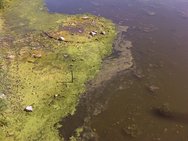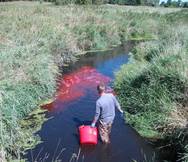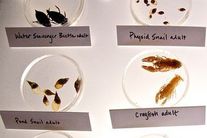|
The Minnesota Pollution Control Agency (MPCA) was not awarded grant funds for the Clean Water Partnership
(CWP) program from the 2015 Legislature. As a result, there will be no CWP grant
funding rounds in 2016 or 2017. Current CWP projects will continue until their
agreement end dates, the last of which will be June 30, 2018.
Although there will be no grant funding, there is almost $11 million
available for CWP loans in the next biennium. In order to take advantage of
this opportunity, as well as the Governor’s Buffer Initiative, the CWP loan
program is developing an open funding process for loan-only applications that
allows project sponsors to apply and receive loan funding at any time during
the year. Details of the process are still being finalized, but are expected to
be available soon.
If you have any questions please contact Pete Fastner
of the MPCA Watershed Section at 651-757-2349, peter.fastner@state.mn.us

The
Minnesota Dept. of Natural Resources (DNR) is accepting applications for its
Conservation Partners Legacy grant program. This program funds conservation
projects that restore, enhance, or protect forests, wetlands, prairies, or
habitat for fish, game, and wildlife in Minnesota. Grant requests may range
from $5,000 to $400,000 with a maximum total project cost of $575,000.
Nonprofit organizations and government entities are eligible to apply, and a
10-percent match of non-state funds is required. Funding for this program comes
from the Outdoor Heritage Fund.
For
the Traditional and Metro grant cycles, $6.8 million is available. These
projects must be on public lands or waters or on lands protected by a permanent
conservation easement. Apply by Sept. 14.
For
the Expedited Conservation Projects
(ECP) grant cycle, $1 million is
available. These grants, up to $50,000, are for eligible activities on public lands
or waters open to all seasons of hunting and fishing. This cycle is open
continuously for applications until May 18, 2016, or until all funds are awarded. Apply by Sept. 16 for the first
round of funding.
Visit these webpages for details:
Questions?
Please email lscplgrants.dnr@state.mn.us
for more information.
|

Farming and conservation representatives from 20 states,
Washington D.C., and one Canadian province visited five farms in southeast Minnesota
Aug. 12 as part of a tour organized by the Conservation Technology Information
Center. The tour highlighted successful projects and partnerships in
conservation agriculture.
During the expo and lunch stop at the Dave Legvold farm
outside Northfield, MPCA Commissioner John Linc Stine spoke on how his agency
can be an effective partner with farmers.
The extensive water quality data being collected by the MPCA
– thanks to Legacy Amendment money – means the agency can work with farmers and
landowners to detect and diagnose problems.
“Like a patient going to the Mayo Clinic for testing and
treatment, we hope that our water quality assessments will help develop a
diagnosis for our waters that don’t meet standards,” Stine said.
Generally, Minnesota needs to reduce levels of nutrients,
sediment and bacteria in a majority of akes and streams. The MPCA wants to work with
landowners and regulated parties to make choices and plan the state’s future
with water quality in mind, he said.
“We know what it takes to have productive soil and water
quality,” the commissioner said. “It’s no mystery. It takes soil stability. It takes
nutrient reduction. It takes water retention. It takes all of us working
together.”
Photo above: Farmer Dave Legvold, at left, receives
congratulations from MPCA Commissioner John Linc Stine on being the newest recipient
of the Minnesota Ag Water Quality Certification, a voluntary program for
adopting practices that help water quality. See more of how Legvold farms in
this MPCA story and program: On-farm
research: Results that count for profits, water quality.
|
The Red River of the North is one of Minnesota’s five largest
rivers to be targeted by a MPCA intensive water quality monitoring effort.
The MPCA is half way through a 10-year effort to assess the
condition of smaller rivers, streams and lakes throughout Minnesota’s 81
watersheds. The state’s largest rivers — the Mississippi, Minnesota, Rainy, Red
and St. Croix — are being studied to complement that effort.
During the warm months of 2015-16, MPCA monitoring crews will
travel the Red River from its headwaters in Breckenridge to the Canadian
border. A crew is currently working in the area between Wahpeton and Fargo.
Twenty-nine smaller watersheds flow into the Red River before it
crosses the Canadian border. By combining the results of ongoing monitoring in these
smaller watersheds with results from the Red River, the MPCA can obtain a more
complete picture of water quality conditions in the area and potential problem
areas.
To see monitoring teams in action, you can watch short videos on
fish
sampling and invertebrate sampling on the MPCA’s website.

The MPCA is seeking feedback on a chloride
pollution reduction report in metro area lakes, streams, and wetlands.
Thirty-seven waters were found to have chloride levels that violate state water
quality standards. All other waters and groundwater are in need of protection
to prevent chloride
contamination.
The plan characterizes the impacts of chloride on water resources
across the Twin Cities. Chloride pollution occurs when salt used for de-icing
and water softening makes its way into lakes, streams, and wetlands. This happens
through snow melt and wastewater discharge or septic systems. Once in the
water, chloride remains in the environment and continues to accumulate over
time.
A key challenge in reducing salt usage is balancing the need for
public safety with the growing expectation for clear, dry roads, parking lots,
and sidewalks throughout the winter. Many road authorities have made notable
efforts to reduce salt usage while maintaining public safety. The Chloride
Management Plan is intended to build on those efforts to determine salt
reduction strategies to restore and protect Minnesota’s water resources.
Comments on the report should be submitted in writing by 4:30
p.m. Sept. 2 .to Brooke Asleson, 520 Lafayette Road N., St. Paul, MN
55155-4194, or brooke.asleson@state.mn.us.
Written comments must include a statement of your interest in
the report; a statement of the action you wish the MPCA to take, including
specific references to sections of the draft report you believe should be
changed; and specific reasons for your position.
|

Lakes
and streams in the Shell
Rock River watershed in southern Minnesota are suffering multiple stressors
that hurt fish and other aquatic life, according to a study by
the MPCA.
This
drainage area totals about 254 square miles, all in Freeborn County, with the
largest city being Albert Lea, population 18,000. The majority of the watershed
is farmed for corn and soybeans with an extensive drainage system. Fountain
Lake, in the center of Albert Lea, is popular for boating, fishing and other
recreation. Myre-Big Island State Park owns 40 percent of the shoreland of
Albert Lea Lake, which is the first lake in Minnesota to greet travelers on
Interstate 35.
Excessively
high levels of nutrients cause severe algal blooms that stress fish and aquatic
life. Algal blooms also make the water unsightly and smelly for recreation.
Some forms can even be harmful to humans and animals.
The
sources of nutrients include agricultural fertilizer running off or leaching
from fields, manure runoff, and wastewater.
Other
related stressors include:
- Low
or fluctuating levels of dissolved oxygen needed to sustain aquatic life.
- Low flows and
high water temperatures during dry conditions contribute to fluctuations in
dissolved oxygen levels.
- pH levels high
enough to harm fish and other aquatic life by damaging gills and other effects.
- Lack of habitat
due to sediment, which is soil and other particles that cloud the water and
build up on lake and stream bottoms, making it hard for aquatic life to breathe,
feed and reproduce.
- Imbalance of
dissolved salts and minerals that can be toxic to aquatic life.
- Changes in
stream flow to accommodate drainage.
To improve water quality in the Shell Rock watershed, the MPCA
recommends:
- Major
reductions in nutrient levels in the watershed’s streams and lakes by better
management of fertilizer and manure throughout the watershed.
- The Albert Lea
wastewater treatment plant will also need to remove more phosphorus from its
discharge to the Shell Rock River.
-
Preventing
erosion from streambanks, driven by increased flow from drainage, to reduce the
sediment levels in water bodies.
The MPCA and
local partners will include more detailed recommendations in the Watershed
Restoration and Protection Strategies, the document that culminates this first
cycle of intensely studying the watershed.
Recent
media cover of the watershed:
|

The MPCA is seeking comments on a water
quality improvement report for 12-Mile Creek in Wright County. The report,
known as a Total Maximum Daily Load (TMDL), focuses on low dissolved oxygen
levels throughout the creek. The MPCA is accepting comments on the report
through Aug. 26.
12-Mile Creek flows northeast from Little Waverly Lake, just
north of the city of Waverly, and drains into the North Fork Crow River. All
forms of aquatic life depend on minimum levels of dissolved oxygen to live and
grow. Excess sediment and other pollutants entering the creek combine and
consume oxygen that is critical to the health of aquatic life. To help 12-Mile
Creek meet state dissolved oxygen standards, this report calls for significant
reductions of oxygen-demanding sediment and pollutants entering the creek.
A TMDL report is a scientific study that calculates the maximum
amount of a pollutant a water body can receive and still meet water quality
standards.
Comments may be submitted to Margaret Leach, MPCA, 7678 College
Road, Baxter, MN, 56425, or by e-mail to Margaret.leach@state.mn.us.
Written comments must include a statement of your interest in
the draft TMDL report; a statement of the action you wish the MPCA to take,
including specific references to sections of the draft TMDL that you believe
should be changed; and specific reasons supporting your position.
Photo above right: A technician uses red dye to conduct a time of travel study in the creek.
|
Applications
are being accepted for the first Minnesota River Congress action board. It will
govern the group being organized to coordinate and promote work to improve
natural and economic resources in the 15,000-square-mile river basin covering
much of southwestern Minnesota.
About
70 people attending the fourth Congress meeting July 23 approved the
organization structure, application form,
and purpose statements, and affirmed the process under way for
not-for-profit, tax-exempt status.
State
officials attending the Congress in New Ulm expressed support: Reps. Paul
Torkelson and Clark Johnson, DNR Commissioner Tom Landwehr, and DNR southern
region manager Dennis Frederickson. “The Minnesota River basin needs a voice in
the legislative process,” says Rep. Johnson. “This Congress is a major step in
that process.”
The
action board would be composed of one representative from each of the basin’s
13 watersheds, 14 people from sectors including business, agriculture,
recreation, and local government, and six state agency staff. The one-page
application form asks for watershed residence and sector, and a brief statement
of interest and qualifications.
Congress
promoters believe there is a need for a basin-wide organization following the
dissolution of the former Minnesota River Board. Action board application forms
are available by contacting Scott Sparlin, sesparlin@gmail.com.
More information about the Minnesota River Congress is available from the Minnesota Watershed Alliance.
The next Mississippi River Forum will focus on “Parks and
Recreation: Equal Access for All?” with Dr. Raintry Salk of the Metropolitan
Council sharing key findings of her research on park use among select
communities of color throughout the Twin Cities. The forum will be held
- Friday, Aug. 28, from 8-9:30 a.m. at the St. Cloud City Council
Chambers; and
- Friday, Sept. 25, from 8-9:30 a.m. at the McKnight Foundation in
Minneapolis
For more information, including how to join the Aug. 28 meeting via
webinar or phone, see the Mississippi River
Forum webpage on the National Park Service website.

If
going to the Minnesota State Fair Aug. 27-Sept. 7, you won’t want to miss these exhibits at Eco
Experience:
- Bagnado:
A 25-foot-tall tornado made of plastics, demonstrating the vast amount of this
material thrown away by Minnesotans every day.
- Eco
camper: A micro camper made in Minnesota that leaves a small carbon footprint.
- YOXO
toys: Kids can earn these toys made by a St. Paul company from sustainable and
recyclable materials.
- Flush
yourself: Climb into the larger-than-life sink and slide down the drain to
learn what happens when flushing water down a sink or toilet.
-
AgriCULTURE: Discover immigrant food
through daily cooking demos, displays, games and food samples.
- AirBeam: A mobile $250 monitor for air quality.
-
Climate Scale: Jump on the “people’s scale” to show the power
of collective change. On this scale fairgoers can interact with one another and
show how people and neighbors working together can make change.
-
Eco-friendly home
improvements: Learn how to improve
your home step-by-step while saving on energy costs.
-
Citizen scientist: Fair guests can practice being a Citizen
Scientist by learning different frog and owl calls, using a Secchi tube to
measure water clarity and evaluate the health of a stream, and learning the
unique characteristics of Monarch butterflies.
-
Reuse: This area will feature youth- and adult-friendly,
hands-on projects plus daily demonstrations of DIY reuse projects and repair
techniques.
|
|